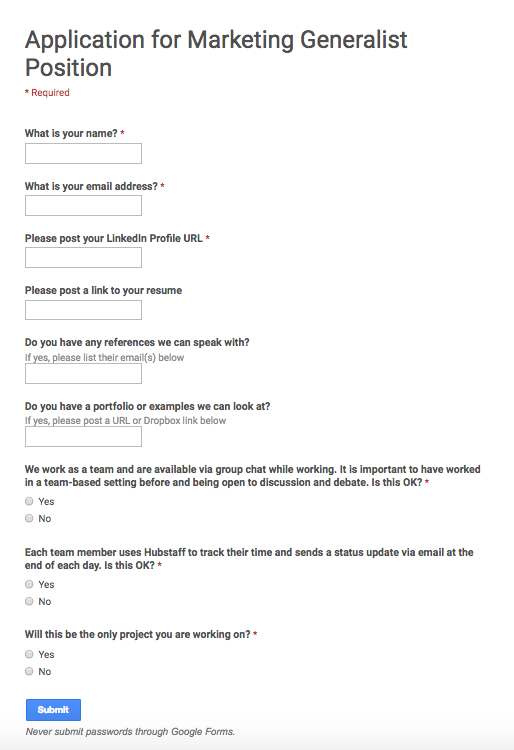
How do you build a strong remote team?
With remote work comes renewed challenges: coordinating a team spread across many time zones, ensuring each milestone gets completed in time, and catching communication breakdowns before they escalate (just to scratch the surface).
The reality, however, is that remote work is a huge driver for competitive advantage and it is gaining ground among businesses of all sizes and industries.
A Gallup report shows 37% of employees in the US have engaged in some form of remote work in 2017. That’s because remote teams can tap into large, untapped pools of talent beyond their geographical boundaries. Also, going remote eliminates real estate and personnel overheads for businesses.
Last but not least, ‘ remote work productivity’ has been on everyone’s mind for a quite a while. Remote employees are reportedly happier than ‘traditional’ employees (8.10 vs 7.42 on the ‘happiness scale’) and what better way to boost productivity than keeping your team happy and relaxed?
Once you consider a remote work model for your business and say yes, here's how you can identify, hire and onboard remote rockstars for your business. This post breaks helps you identify:
Four signs of a great remote employee
There are plenty of traits to look for when making just about any hire. But to hire remote employees that truly excel, some characteristics can tip the balance.
1. They’re not just skilled, they’re experts in their field
In an increasingly competitive global economy, finding people who can perform highly specialized tasks can be difficult. With so much talent available globally, remote hiring creates a unique opportunity for companies to reach individuals with specific or targeted skill sets. So, it is becomes necessary for an employer to screen the candidate via AI-based pre-employment screening solutions and other background screening services on their respective skills. As a result, churn and hire the experts and rockstars remotely.
2. They can perform on the job without external motivation
Obviously, the rigors of an office environment - tracking work hours, observing employee dynamics, etc - don’t quite apply to a remote team. So the ability to organize and stay motivated in the absence of external guidance/incentive becomes a critical requirement in a remote employee.
As GitHub puts it, the ideal remote employee is “self-motivated enough to stay productive without someone looking over their shoulder and checking up on them all the time.”
 Source: Pixabay
Source: Pixabay3. They’re as great at listening as they are at speaking
Word has it that software engineers are introverted. You’d be surprised to learn how many creative career professionals are actually introverts—from salespeople to social media managers!
In a remote hire, communication skills should be evaluated by more than the ability to talk or the count of project updates shared. Great communicators are proactive, empathetic, express themselves clearly, and make sure their message is understood. They also have fantastic interpersonal and listening skills that must be assessed from the very first interaction.
Need help understanding if remote work is right for your business? We created The Flock Guide to Building Great Remote Teams with leaders like you in mind.
4. They are more productive when they focus on results, not procedures
Remote team members naturally have less visibility into operational procedures and how they come to be. So it is critical that remote employees keep their eye on the ball and focus first and foremost on achieving business goals.
“We are results-oriented by necessity,” say the folks over at FlexJobs. Even Toggl, a remote team behind the fantastic time tracking app, says that they have a “result-oriented culture and everyone’s productivity is measured by their results.” While they do track hours put in by everyone, productivity is measured based on the results and not on hours worked.
Setting your remote hiring process up for success
So you know what to look for in a great remote employee, but what about your hiring process? Hiring remotely also involves adapting your hiring process to the realities of remote employees possibly by incorporating the best applicant tracking systems. During new employee onboarding , take time to set standards for communication and make sure no one gets left out of social conversations within the team.
Set clear expectations before you even start interviewing
Hiring remote talent can curtail your opportunities at face-to-face interactions. Hubstaff offsets this by kick-starting the conversation straight from their hiring ad. They directly ask candidates if they can work hours that overlap with specific time zones, or whether they are okay with tracking their time and sending a status update via email at the end of each day.
Including a mini-questionnaire inside your ad increases your chances of finding applicants that match your expectations. Here is Hubstaff’s questionnaire for a Marketing Generalist role.

Instead of asking “What were the biggest challenges you faced at your previous job and how did you overcome them?” Skillcrush prefers questions like “How do you schedule your workday?” or “What communication tools do you use in different situations?”
Try to steer clear of routine questions that can lead to prepared answers when you evaluate skill and cultural fit. This helps you spend zero time on candidates that are not a good fit and sets accurate expectations about your team culture and hiring process.
When sourcing candidates, think of less conventional places where you can find new talent
Think beyond LinkedIn or Indeed. Where do people meet to bounce off ideas on shared interests? Are they sharing their development projects on GitHub? Are they solving technical challenges on Kaggle? Showcasing their creative work on Dribble or Behance? Answering threads of questions in the Google Advertising community? Identifying great talent is easier when you have proof of their skills and work!
AngelList is a good option if you’re looking for startup-minded talent. You can also look into your own user base (sending a "Hey, we're hiring!" link in emails to customers and blog readers gets Zapier dozens of daily applicants), local meetup groups, or personal network. The right candidate might be just a few clicks away!
Build strong personal connections even when hiring remote employees
Buffer does a great job at this. Once they narrow down the list of candidates they believe are a good fit, they go through not one, but three interviews. The first aims to assess whether the candidate is aligned with the culture and values of the company. The second interview is more role-specific as it is meant to evaluate the candidate’s experience. The last one is to assess the candidate’s critical thinking and empathy skills. When those candidates are located overseas, working with an employer of record companies ensures you can legally hire them, manage payroll in their country, and stay compliant with local employment laws while your team focuses on the interviews and cultural fit
Yonder recommends live video interviews so both parties can get a feel for one another. Video calling is also a good way to tell if the candidate is familiar with video conference software, acts professionally, and is flexible to meet on a different timezone.
Revisit your testing methods when evaluating remote employee skills
A test project is the best way to tell a good profile from a great fit. Since remote hiring makes it difficult to test candidates in a controlled office environment, third-party software and services can help.
Formstack asks candidates to complete a small on-the-job task to evaluate actual work, creativity, and ability to solve problems. When hiring developers, X-team prefers to use their own tests “rather than use a third-party service like HackerRank or Codility.”
But testing doesn't always have to be about a score or getting some sort of useable output, says Baremetrics. “It’s about figuring out if they can hit the deadlines they set, if they’re actually able to do the caliber of work they’ve shown before, and if they respond well to criticism.”
Perform a reference check to get insight into work experience and personality traits
Reference checks still carry a lot of weight. For example, GitLab dropped all test projects in favor of reference calls.
Before making an offer, Zapier sends out an anonymous survey using SkillSurvey. Though this adds length to the hiring process, it helps to get honest feedback on candidates from references.
Best practices for onboarding remote employees
Onboarding can make or break the success of a new remote hire. Which is why even remote companies with effective onboarding systems are constantly looking for ways to improve them.
For example, until recently, a new hire at Buffer went through a 45-day bootcamp to give both the employee and the employer time to ensure that they were a great fit. This system worked well but feedback from teammates showed that it did not create the best environment for folks to do their best work. Buffer’s new philosophy is that a new teammate is “a full teammate from Day 1” in an effort to make a new hire’s first few weeks feel more like “an encouraging welcome instead of a 45-day period of auditioning.”
Find the best way to introduce new remote employees to the team and projects
There are many ways to introduce a new team member, from a company-wide video call to an introduction via email or chat. You can also share onboarding videos with them. These materials deliver job-specific information and help ease transition challenges. Trello takes a “lean” approach to introductions by assigning specific peer mentors to new members of the team. Mentors are the ones who help new hires meet other employees and send out introductory emails to the company.
Whatever way you choose to manage how new team members are introduced, make sure to alleviate anxiety by clearly defining roles and assignments, and showing new members where to turn for help.
 Source: Pixabay
Source: PixabayMake sure goals and timelines are clear from day one
“Leave nothing to the imagination,” says Johnathan Solorzano of Solo Media Group. Setting clear, achievable goals during onboarding will inspire a sense of mission and purpose in your new remote employees.
“(...) the chain of command should be communicated clearly and effectively,” thinks Vincenzo Villamena of Online Taxman.
There is no better time to communicate company values, objectives, goals, and timelines than during onboarding. When remote employees have clarity on their tasks in terms of timelines and expected outcomes, they are more productive. As Upworthy co-founder Peter Koechley puts it, make people thrive by giving them “a clear, meaningful mission.”
Anticipate and mitigate personal challenges by allowing flexible work schedules
In a distributed team, you really have to plan for flexibility. Buffer accommodates time zone differences by communicating “ as asynchronously as possible” using email, Discourse, or starting a project in Dropbox Paper, instead of using a team chat tool all the time. They also change up meeting times so that they are available to people across time zones.
Derek Robinson at Top Notch Dezigns notes that “when you pay attention to your remote worker’s time zone, it’s a clear sign of solidarity. He or she is bound to remember the gesture and will reciprocate in other ways.”
Make it super easy for new teammates to be a part of the community
Regular video conversations and occasional in-person events are important to establish a sense of community at Online Taxman, but they may not work for every team.
Find what works for your team. It could be company retreats every 6 months like the ones at Zapier, or the messaging equivalent of water cooler conversations. During onboarding, take time to set standards for communication and make sure no one gets left out of social conversations within the team.
Be open about business performance indicators to create a culture of transparency
Hotjar creates a culture of trust by opening up their monthly leadership calls for any team member to join. The company’s financials are accessible to everyone in the team and people are encouraged to discuss anything with the entire team.
Buffer takes it to the next level. Employees know each other’s salaries, what projects other teams are working on, and have access to monthly investor reports and financial updates.
Use Objectives and Key Results (OKR) to align your teams around goals and results, by giving employees visibility into what others are working on. Many companies including Spotify, Piktochart, Twitter, LinkedIn, or Airbnb are finding success using OKRs.

A remote team is only as good as the process you use to put it together

Source: Stokpic
Hiring remotely is a great way to grow your business without trading efficiency and flexibility. It is also the key to building a more engaged and productive team.
But a remote team is only as good as the process you use to put it together. Invest time and effort into designing a robust remote hiring process and you will find it becoming the secret ingredient to your business success.






